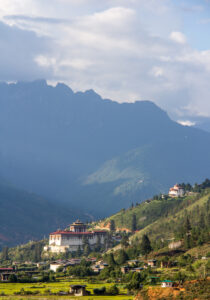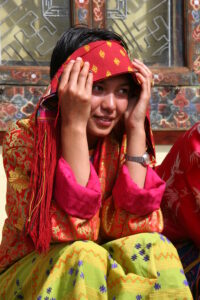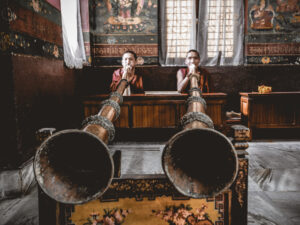At a Glance
Duration: 17 nights, 18 days
Group Size: Up to 16 participants in a group
Tour Grading: Moderate and Adventure
Activity: Cultural, Arts, Heritage and Hiking
Sights:
SIKKIM: Char Dham, Namchi Guru Statue, Pelling, Khecheopalri Lake, Pemayangtse Monastery, Rabdentse Ruins, Sanga Choling Monastery, Gangtok, M. G. Marg, Lal Bazaar, Tashi Viewpoint, Cottage Industry, Namgyal Institute of Tibetology, Rumtek.
BHUTAN: Tiger’s Nest monastery, Punakha Dzong, Paro Dzong, Phobjikha Valley, Thimphu Centenary Market, Kuenselphordang, Painting School of Arts and Crafts, Textile Museum, National Museum, Madman Temple.
Best Season: February, March, April, May, August, September, October and November
Trip Route: Delhi – Bagdogra – Turuk – Namchi – Pelling – Gangtok – Phuntsholing – Paro – Thimphu – Punakha – Trongsa – Bumthang – Punakha – Paro
BHUTAN, the ultimate last Shangri-La, and the Dragon Kingdom are blessed with ancient monasteries, Dzongs, monks, and majestic mountains with rich cultural heritage. It’s considered one of the few unexplored tourist destinations in the world. No wonder a tour in Bhutan is a cultural experience in itself, and witnessing the Dragon Kingdom high up in the Himalayas, still untouched by modernization, is a different experience.
SIKKIM: The gate of north-eastern India opens with the mesmerizing experience of Sikkim. Explore rugged, snowy mountains to find the perfect gateway. Sikkim is not only the cleanest and least populated state of India, but it is also known for its holy Tibetan and Sikkimese culture and traditions. With snow-capped mountains, flower-clad valleys, desirable frozen lakes, a robust Kanchenjunga range, forest reserves, remarkable Tibetan-styled delicacies, and spiritual chanting everywhere (om-mani-padme-hum) Sikkim has every reason to be a nature personification.
Trip Highlights
SIKKIM
• Char Dham
• Khecheopelri lake
• Rock Garden
• Lal Bazaar food
BHUTAN
• The only capital in the world without traffic lights
• Bhutan Postal Museum, Evolution of Communication Systems in Bhutan
• Stunning Punakha Dzong
• Stunning views from the passes of Pele la and Yotong la
• The Vanguard of the Warriors, Trongsa Dzong (fortress), Ta (watchtower) Dzong
• Chimi Lhakhang, the temple of fertility
• Tiger’s Nest: an exhilarating task of 2 hours of climbing and another 1.5 hours of retrieving steps
Day 1: Arrive in Bagdogra; Drive to Turuk
Upon arrival at Bagdogra (India) airport, meet our representative and drive to Melli, the gateway to Sikkim. Complete immigration formalities at Melli and continue further to Turuk, a small village near Melli. A tranquil retreat with astounding natural beauty.
Overnight in the hotel.
Day 2: Day excursion to Namchi
In the morning, wake up to the spectacular sunrise over the mountaintop and later take a walk to Tarey Bhir to experience the splendid views of Kalimpong and Darjeeling hills. Later, you can drive to Samdrupse Hills (the wish-fulfilling hill), where you will see a great statue of Guru Rimpoche and the Samdrupse monastery. Visit Ngadak monastery and the Char Dham complex as per your interest. In the evening, return to Turuk Kothi.
Namchi Guru Statue (Samdruptse), which translates as “the wish-fulfilling hill” in the local Bhutia language, is a short distance uphill from Namchi. On Samdruptse Hill stands a giant statue of Guru Padmasambhava, gazing upon the town and across the hills. It is 45 meters tall and covered in shimmering gold, which sparkles in the sun. It is an incredible feat of engineering, founded in 1997. The views are spectacular, and the statue can be seen from many places in Sikkim and Darjeeling. The foundation stone of the statue was laid by His Holiness, the 14th Dalai Lama, on October 22, 1997.
Ngadak Monastery is located a short distance of about 10 minutes from Namchi and is one of the oldest monasteries in Namchi. It was built by Tensung Namgyal during the period of Chogyal Gyurmed Namgyal. This monastery was constructed as a palace for Her Highness Pendi Ongmu. A new monastery is under construction as the old structure suffered damage during an earthquake in the 17th century. It is believed that whoever visits this monastery has to make a promise to visit again. Therefore, it is called Ngadak, which means promise in the local language.
Char Dham is a huge pilgrimage and cultural complex that covers an area of 29 hectares on Solophok Hill in Namchi. This place was developed by the government of Sikkim to promote religious, eco, and village tourism in the state. The main temple is 108 feet high, towering with an 87-foot-tall statue of Lord Shiva along with the twelve Jyotirlingas. Apart from this, the complex contains replicas of the four Dhams Badrinath, Jagannath Dwarika, and Rameshwar, which are highly revered by the Hindus, and a temple dedicated to Sai Baba.
Overnight in the hotel.
Day 3: Turuk to Pelling
After breakfast, ascend the hills and drive towards Pelling, a small town in West Sikkim that has become a bustling tourist destination. From here, one can view Mt. Kanchendzonga, Mt. Pandim, Mt. Siniolchu, and other ranges. It is an exotic settlement with varieties of rhododendrons, orchids, historical sites, short trek routes, and wildlife. At the hillock is the Pemayangtse monastery, the premier monastery in Sikkim belonging to the Nyingmapa sect, which is the head of all other monasteries of the sect in Sikkim.
Overnight in the hotel.
Day 4: Pelling Sightseeing
After breakfast, start your full-day sightseeing tour in and around Pelling. Begin with Rimbi Falls, Rock Garden, Kechodpalri Lake, Kanchenjunga Falls, Sewaro Rock, etc. Later in the afternoon, you can take a walk to Pemayangtse Monastery, Sangacholing Monastery, and the ruins of Rabdentsey.
Overnight in the hotel.
Day 5: Gangtok
After breakfast, continue your journey through forests, rivers, and many small villages and towns, and gradually climb up to Gangtok. Once an independent Himalayan kingdom, Sikkim was annexed by India in 1975, but the town still retains some of its traditional cultural values, giving us a rare opportunity to discover something of the cultural heritage of this lively hilltop town. In the evening, take a short walking tour through MG Marg Avenue and browse the colorful Lal Bazaar food and vegetable market.
Overnight in the hotel.
Day 7: Gangtok Sightseeing
After breakfast, visit the Enchey monastery, followed by some viewpoints like Ganesh Tok, Tashi View Point, and Hanuman Tok, from which you may get spectacular views of the city and the snow-capped peaks of Kanchendzonga. Later, you can also stop by the cottage industry, where you can see and buy traditional handicrafts. Later in the afternoon, visit the Institute of Tibetology and the Do Drul Monastery.
Overnight in the hotel.
Day 8: Gangtok to Phuntsholing (Bhutan)
After breakfast, drive down to the valley floor and up the opposite ridge to the Rumtek monastery, the seat of the 16th Gyalwa Karmapa, head of the Karma Kagyu school of Tibetan Buddhism. The monastery is the largest in Sikkim and a replica of Karmapa’s monastery in Tsurphu, Tibet. Following the visit to Rumtek Monastery, continue your journey to Phuentsholing.
Upon arrival, meet our representative for the rest of your Bhutan tour.
Overnight in the hotel.
Day 9: Thimphu
After breakfast, drive to the capital city of Thimphu for 6 hours, check in to your hotel, and rest or stroll around the city.
Overnight in the hotel.
Day 10: Thimphu Sightseeing
Folk Heritage Museum: The restored three-story timber building replicates a traditional farmhouse and gives a pure glimpse into rural Bhutanese life and its households. To maintain our knowledge of indigenous natural resources, native trees and plants that had domestic uses in a rural Bhutanese household are grown, creating an oasis of greenery right in the heart of the capital city of Thimphu.
National Textile Museum: Under the royal patronage of the youngest Queen Mother, Ashi Sangay Choden Wangchuck, the museum preserves the national textile and helps women's empowerment. They help women from the central and eastern parts of Bhutan through weaving. The museum also focuses on royal ghos, including the wedding clothes worn by the fourth king and his four wives.
Centenary Farmers’ Market: Every Saturday and Sunday, most of the Thimphu population congregates on the banks of the river, where the weekend market is held. Here, villages from the valley and other nearby villages come to sell their agricultural products.
Afternoon: visit the Post Office Museum and make customized stamps. The museum was established in November 2015 to commemorate the 60th birthday of the fourth king. The museum tells the story of Bhutan’s development and progress over time. Methods such as anecdotes, artifacts, and the rich assortment of stamps the country has developed are used.
Jungzhi Paper Factory: The tree barks of Daphne and Dhekap are used to make this traditional paper. You could indulge in the whole process and try making souvenirs of your own. The paper was originally used by monasteries for manuscripts and prayer books.
In the evening, drive to Kuensel Phodrang, Buddha Point. This 169-foot bronze statue of Buddha Dordenma, Vajra Throne Buddha, symbolizes indestructibility. The view of Thimphu Valley from this point is spectacular and beautiful, especially at night.
Overnight in the hotel.
Day 11: Punakha
Today, after breakfast, we will drive back to Punakha Valley (1220m). Punakha served as the capital of Bhutan until 1955, and today it is the winter residence of the Central Monk Body.
On the way, we will stop at Do Chula Pass (3150m) to see 108 Chortens, and if we are lucky, we will see the spine of the Himalayas. Keep an eye on Gangkar Puensum, which is the world’s highest unclimbed mountain.
With a lunch stopover at Messina, we will then visit the Mad Man’s Temple (Chimi Lhakhang), built in 1499 and located on the hillock in the center of the valley. It is dedicated to Lama Drukpa Kunley (1455–1529), who used humor, songs, and outrageous behavior to dramatize his teachings and hence was also known as "Divine Madman.”. It is widely believed that childless couples who pray at this temple are usually blessed with children.
In Punakha, we will drive along the Pho Chu River, then cross the suspension bridge, and after a short, pleasant walk, enter the historic 17th-century fortress “Punakha Dzong.”. It was built in 1637 by Zhabdrung Ngawang Namgyal and is connected to Bhutan’s historical traditions.
Overnight in the hotel.
Day 12: Phobjikha
Today, we walk up to Khamsum Yulley Namgyal Chorten. The mother of our 5th king built this monastery, which took eight long years to complete. A bridge provides access to a sweaty 45-minute hike uphill to the chorten. To avoid the heat, an early morning start would be advisable. Beyond the chorten, the road leads up to Kabesa village and Uma Como to Tashithang, then continues to the Gasa Dzong and the ending point of the Laya-Gasa trek.
After lunch, we then drive to Phobjikha (Gangtey) Valley (3000m).
Phobjikha (3000m) is the country’s highest wetland and the winter home for over 400 black-necked cranes. These birds are endangered species, and every winter they come to roost here from Tibet.
In Phobjikha, after checking in to the hotel, we do the nature trail walk, – the best and most popular short walk (1.5 hours) and leads downhill from the mani stone wall just north of the Gangtey Goemba to the Khewa lhakhang. The trail further descends to Semmchubara village, drops right at the chorten into the edge of the forest, and calls it a night.
Overnight in the hotel.
Day 13: Bumthang
Today in the morning, we will walk up to the newly renovated Drechagling monastery in Ngenglung. It is near Hotel Dewachen and was first established by one of the greatest Buddhist masters, Longchenpa (1308–1363). After this visit, we drive to Bumthang (2650m).
En route, we stop at Trongsa for lunch and visit Trongsa Dzong, the ancestral home of Bhutan’s monarch, where novice monks recite mantras or practice on sacred horns, flutes, and drums. Bumthang is 68 km from here. The drive to Bumthang takes you over the picturesque Yotong La Pass and down into Chhume Valley, home to Bhutan’s famous Yatra weaving. See the weavers create their intricate handiwork and browse the finished textiles.
Overnight in the hotel.
Day 14: Explore Bumthang
Begin the day by exploring the Palace of Wangdichhoeling, home to the second king. Note the auspicious prayer wheels, then head up the valley, taking in the grand Kurjey Lhakhang, considered one of Bhutan’s most auspicious monuments. Once the resting place of Guru Rimpoche and Jambay Lhakhang, Kurjey Lhakhang is where the early winter festivals are held, drawing thousands of Bhutanese to receive blessings. Head back to town and visit Tamshing Monastery. Visit Maebar Tsho, one of Pema Lingpa’s greatest finds—Maebartsho or “Flaming Lake”, which is one of the great pilgrim sites of Bhutan
Overnight in the hotel.
Day 15: Punakha
Today we drive back to Trongsa for lunch and visit Ta Dzong if we missed it earlier. Now being converted into a museum, it has an unusual tower section with wings extending in front of the main building. Entering this, you can visit the chapel dedicated to Jigme Namgyal and enjoy a bird's-eye view of the Dzong stretched below you.
We then drive onward to Punakha. In the evening, check into the hotel and rest.
Overnight in the hotel.
Day 16: Paro
Morning drive to Paro followed by an orientation tour of Paro Valley’s main sights, including the Rinpung Dzong with its cantilever bridge, Kyichu Lhakhang, a most revered temple boasting an orange tree that perpetually bears fruit, and the ruins of the Drugyel Dzong, the site of the fort of Drukpa victory from which the Bhutanese effectively repelled constant attacks from Tibet, and from where, on clear days, the 24,000-foot snow-domed peak of awesome Mt. Jumolhari can be seen.
Overnight in the hotel.
Day 17: Paro
By now, we may have acclimatized to preparing to walk up to the famous Tiger’s Nest. The monastery is the most famous in Bhutan and has recently been listed as one of the ten holiest places in the world. This is one of the highlights of the trip.
It’s perched on a high cliff, 900 meters above the floor of Paro Valley. It is named Tiger’s Nest because Guru Rimpoche is said to have flown to the site on the back of a tigress in the 8th century. This monastery is the holiest in Bhutan. The five-hour walk to the monastery, involving some intense but rewarding climbing over 900 meters, cleanses both the soul and the body.
Overnight in the hotel.
Day 18: Departure Transfer
After an early morning breakfast, depending on the flight schedule, drive to Paro International Airport for departure to the onward destination and bid farewell.







